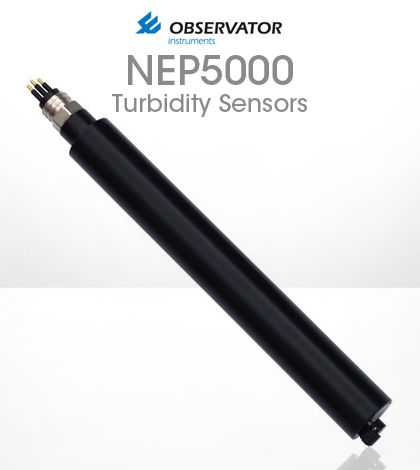Observator ANALITE NEP5000 Turbidity Sensor: High-Accuracy, Multiple Ranges

Because of the large number of parameters that they can track, water quality sondes can be used in a variety of applications. But what if you just need to monitor turbidity? For environmental pros who are in this pinch, the Observator ANALITE NEP5000 Turbidity Sensor is a good option.
This sensor combines high-accuracy turbidity measurements, from 0 to 5000 NTU, with what is one of the most deployment-flexible designs out there. That’s because it has been built to work with all popular communication languages and controller devices on the market. Just wire it up with the needed cable length and it’s ready to log.
“The NEP5000 series of turbidity sensors has many features, but one of the most prominent is the adaptability of this sensor to work with all available controllers, loggers, and portable devices,” said Dana Galbraith, general manager at Observator Instruments. The NEP5000 can interface with communication modes including RS422, RS485, RS232, SDI-12, Digital TTL, current at 4 to 20 milliAmps and voltage at 0 to 5 volts.
The sensor is also compatible with USB protocol, Galbraith says, which is a useful capability for those concerned with cost. By combining the USB connectivity with a tablet computer or USB-equipped smartphone, users can achieve the measurements they need in a streamlined and inexpensive package.
This option “represents the most cost-effective logging handheld and turbidity sensor combination available,” said Galbraith.
Going that route requires using the sensor’s configuration kit to set everything up. But otherwise the kit is a must for routine calibrations and maintaining sensor performance. The software helps with this by providing a usage report that can pinpoint sensor issues. It is also used for loading firmware updates to the sensor and moving configuration files.
The only other maintenance concern for the NEP5000 is biofouling, something that can affect all sensors deployed in aquatic environments. Galbraith says that a protective shroud accessory helps to minimize the impacts of biofouling, as does an integrated wiper that routinely cleans the optical sensor face during deployments. For high-biofouling environments, the company also offers copper components for increased protection.
But the sensor is also well suited for other applications where biofouling isn’t a concern. These include projects in laboratories, water treatment plants or food processing operations.
Regardless of where the sensor is deployed, Galbraith says the NEP5000’s accuracy is what sets it apart. This is complemented by the fact that it can measure at multiple NTU ranges depending on user needs. For example, a retro-scatter version of the sensor can track turbidity from 10,000 to 30,000 NTU.
“We offer more range, more connectivity options, but most importantly better accuracy, near-zero stability, and linearity,” said Galbraith.




0 comments